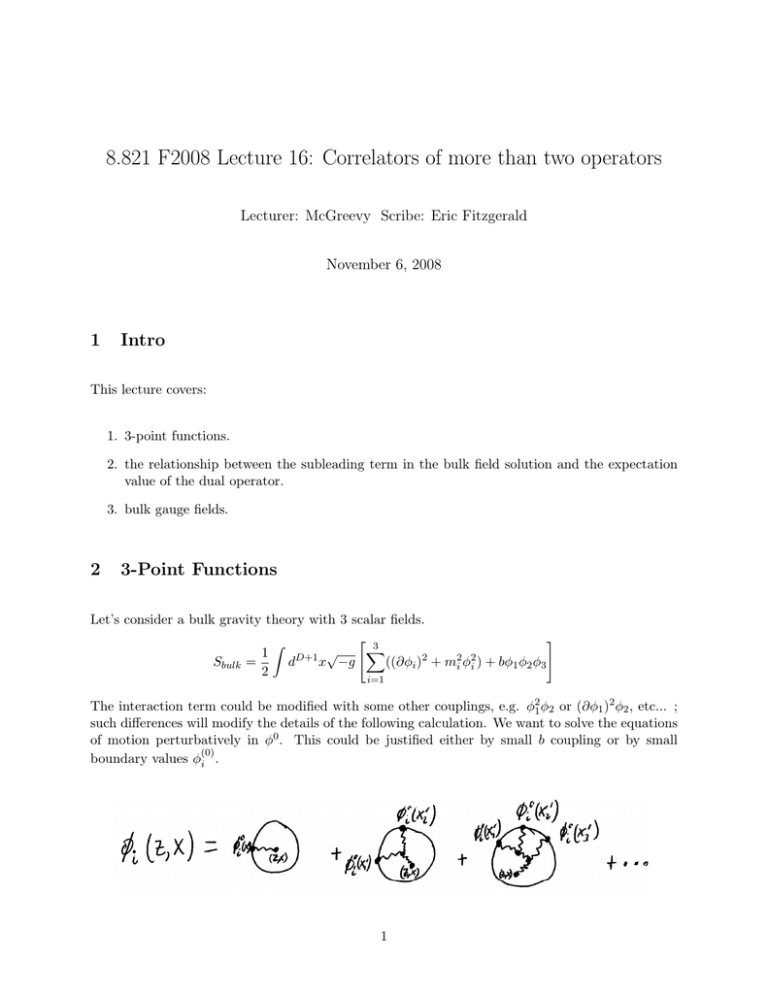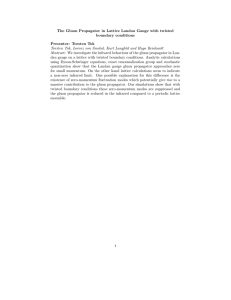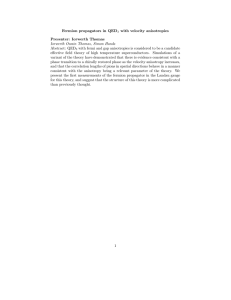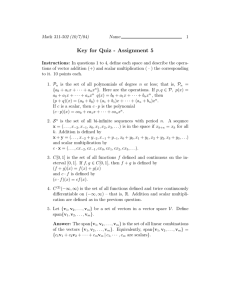8.821 F2008 Lecture 16: Correlators of more than two operators 1 Intro
advertisement

8.821 F2008 Lecture 16: Correlators of more than two operators Lecturer: McGreevy Scribe: Eric Fitzgerald November 6, 2008 1 Intro This lecture covers: 1. 3-point functions. 2. the relationship between the subleading term in the bulk field solution and the expectation value of the dual operator. 3. bulk gauge fields. 2 3-Point Functions Let’s consider a bulk gravity theory with 3 scalar fields. " 3 # Z X 1 D+1 √ 2 2 2 Sbulk = d x −g ((∂φi ) + mi φi ) + bφ1 φ2 φ3 2 i=1 The interaction term could be modified with some other couplings, e.g. φ21 φ2 or (∂φ1 )2 φ2 , etc... ; such differences will modify the details of the following calculation. We want to solve the equations of motion perturbatively in φ0 . This could be justified either by small b coupling or by small (0) boundary values φi . 1 This is just like a Feynman diagram expansion; these “Witten Diagrams” also keep track of which insertions are at the boundary of AdS. Z Z √ D 0 ∆i 0 0 0 φi (z, x) = d x K (z, x; x )φi (x ) + b dD x0 dz 0 −gG∆i (z, x; z 0 , x0 ) × Z Z D × d x1 dD x2 K ∆j (z, x; x1 )K ∆k (z, x; x2 )φ0j (x1 )φ0k (x2 ) + · · · The diagram with three insertions at the boundary won’t contribute to the vacuum 3-point function, since its contribution to the on-shell action will be at least quartic in φ0 (and the three-point function δ3 0 is obtained by acting with δφ 3 on the action and setting φ = 0). The ∆s that are running around are the weights of the primary operators for the scalar field insertions. The Gs and Ks are just spatial propagators for our theory. G(z, x; z 0 , x0 ) is the bulk-to-bulk propagator, defined as the normalizable solution to 1 ( − m2i )G∆i (z, x; z 0 , x0 ) ≡ √ δ(z − z 0 )δ D (x − x0 ) −g which is otherwise regular in the interior of AdS. The bulk-to-boundary propagator K is defined as: 1 K(z, x; x0 ) ≡ lim √ ~n · ∂G(z, x; z 0 , x0 ), 0 z →0 γ √ where γ is the boundary metric and ~n is the outward pointing normal at the boundary. The bulk-to-bulk propagator and bulk-to-boundary propagator are related by1 : ∆ G∆ (z, x; z 0 , x0 ). z → 2∆ − D K ∆ (z, x; x0 ) = lim 0 Of course, these have actual, real live expressions that can be put in terms of hypergeometric functions. Just in case you ever need them: ∆ ∆+1 ∆ 1 ∆ 0 0 −∆ G (z, x; z , x ) = c∆ η F1 , ;∆ + 1 − , 2 , 2 2 2 η η = c∆ = z 2 + z 0 2 + (x − x0 )2 , geodesic distance in AdS, 2zz 0 2−∆ Γ(∆) . (2∆ − D)π D/2 Γ(∆ − D/2) To compute 3-point functions, we plug φ into the on-shell action S[φ]. After an integration by parts, the action becomes: 3 S[φ] = 1X 2 i=1 = 1 Z D+1 d √ b x∂µ ( −gφi ∂ µ φi ) − 2 I + Z √ dD+1 x −gφ1 φ2 φ3 + c.t. II The proof of this relation follows from “Green’s second identity” Z Z ` ´ (φn · ∂ψ + (n · ∂φ)ψ) φ( − m2 )ψ + (( − m2 )φ)ψ) = U ∂U with φ = G, ψ = K. 2 ∀φ, ψ The first term (I) vanishes by properties of the bulk-to-bulk propagator; this is true in general for n ≥ 3. This is glossed over in many discussions of this calculation. We will not prove it directly, but it follows immediately from the result in §3 below. Anyway, the bulk term is non-zero and that’s what we’ll compute. b II = − 2 Z D √ d xdz −g 3 Y K ∆i (z, x; xi )φ0i (xi ) i=1 So with this in hand we can find the 3-point function by functional differentiation using the GKPW formula. D R E R e φ0 O = e− SU GRA S[φ0 ] 3 Y ⇒ hO1 (x1 )O2 (x2 )O3 (x3 )iφ0 =0 = Z hO1 (x1 )O2 (x2 )O3 (x3 )iφ0 =0 = b δ δφ0i (xi ) i=1 (II)|φ0 =0 3 √ Y ∆i dD xdz −g K (z, x; xi ) i=1 To see the structure of the 3-point function, we do some work on this integral. First, let’s relabel the coordinates. Let wA = (z, ~x), so w0 = z and w ~ = ~x. We’ll also define (w − ~x)2 ≡ w02 + (w ~ − ~x)2 . In this case, x0 ≡ 0. With these new coordinate labels, the bulk-to-boundary propagator becomes: ∆ w0 ∆ Kx (w) = . (w − ~x)2 Now we do a change of variables, inversion. Let wA = two claims: 1. dD+1 w wa 0 , w0 2 ~ 0 2 . Now we make where w0 2 = w0 02 + w p p −g(w) = dD+1 w0 −g(w0 ), since inversion is an isometry of AdS. 2. Kx (w) = |x0 |2∆ Kx0 (w0 ). This is how we found K. From these, we can find the transformation of the 3-point correlator. II ⇒ Gfrom (xi ) = 3 3 Y i=1 Some more claims: 3 II 0 |x0i |2∆ Gfrom (xi ) 3 1. This is the correct transformation of a CFT 3-point function under inversion (large conformal transformation), denoted I. 2. Translation invariance is clear Tb : xµi → xµi + bµ . We simply redefine the integration variable w̃µ = wµ − bµ to remove the bµ dependence. 3. Special conformal invariance = ITb I, so that’s good. 4. This must be of the required form, since rotational invariance is clear. G3 = Q cijk ∆ij i>j (xi ) This is determined up to cijk . To find cijk , need to do integral. See [DZF]. Translate ~x3 to 0. Then only two denominator factors in G(xi ), and use Feynman parameters. n-point functions proceed quite similarly. The only new complication is that in general one must evaluate some Witten diagrams with both bulk-to-boundary and bulk-to-bulk propagators (which don’t go away). 3 Expectation Values Next we make a valuable observation about expectation values & the classical field. The reference is Klebanov-Witten, hep-th/9905104. The solution in response to a source φ0 at the boundary (in some state) is: 0 φ[φ ] (z, x)] → lim ∆− φ0 (x) + O(2 ) + ∆+ A(x) + O(2 ) z→ In this case φ0 is the source. The function A(x) is a normalizable fluctuation, determined by the source and choice of the propagator (not just to linear order in φ0 ). CAREFUL: The term O(2 ) in the first term can be larger than the A(x) in the second term! Use caution when calculating and expanding! The claim is that: A(x) = R 0 1 1 hO(x)iφ0 = hO(x)e φ O iCF T 2∆ − D 2∆ − D 4 Knowing the one-point function Z hO(x)iφ0 = 1 φ hOOi + 2 0 Z φ0 φ0 hOOOi + · · · allows us to compute all other correlators. So this formula circumvents the need for the on-shell action S[φ], and applies not just in the Euclidean case, but also in the real-time case. We’ll give a diagrammatic “proof”. The value of the bulk field in response to some source can be represented perturbatively by the following collection of diagrams: Z φ(z, x) = dz 0 dD x0 G∆ (z 0 , x0 ; z, x)BLOB(z 0 , x0 ) So we bring all our sources at the boundary into some blob, then connect the blob to our field using the bulk-to-bulk propagator at (z 0 , x0 ). On the other hand, by the GKPW formula, the expectation value of the dual operator takes the form: GKPW O(x)iφ0 = Z = dz 0 dD x0 K ∆ (z 0 , x0 ; x)BLOB(z 0 , x0 ) Now we use our fact about the relation between the bulk-to-bulk and bulk-to-boundary propagators. ∆ K ∆ (z, x; x0 ) z → 2∆ − D G∆ (z, x; z 0 , x0 ) → lim 0 Putting this in, we find the relation Z lim φ(z, x) = dz 0 dD x0 z→ = ∆ K ∆ (z 0 , x0 ; x)BLOB(z 0 , x0 ) 2∆ − D ∆ hO(x)iφ0 2∆ − D To really work, we need the functional derivatives to be away from the support of the sources, e.g. take the φ0i to be δ-functions. But given that, this shows our claim. 5 4 Gauge Fields This last bit is the beginning of the discussion on bulk, massive gauge fields. Consider a CFT with a conserved current Jaµ , e.g. for N = 4 SYM there is a U (1) ⊂ SO(6). This leads to massless gauge fields in AdS. Things coupling to conserved currents are massless. See pset #4. We can imagine a term at the boundary of the form Z Aaµ Jaµ . S 3 ∂(AdS) ⇒ ∂µ Jaµ = 0 ⇒ ∆ = D − 1 ⇒ m2A = 0 This allows us a nice check on the 2-point function of (charged) scalar operators (due to Freedman et al hep-th/9804058) as follows. If under the U (1) the scalar operators transform like: δΛ O = iΛO, and δΛ O∗ = −iΛO∗ , then the 3-point function ∗ hO∆ (x1 )O∆ (x2 )J µ (x3 )i ≡ Gµ123 is related by a Ward Identity to the 2-point function ∗ hO∆ (x1 )O∆ (x2 )i . The Ward Identity for a conserved current is: Z ∗ 0 = δΛ [Df ields]e−S O∆ (x1 )O∆ (x2 ) . The change in the action is: Z δΛ S = ∂µ J µ (x)Λ(x). Putting this all in the Ward Identity will give us something interesting. Let’s define xij ≡ xi − xj , as it will come in handy. Z D µ ∗ ⇒0 = − d x3 ∂µ J (x3 )Λ(x3 ) O∆ (x1 )O∆ (x2 ) ∗ ∗ + h(iΛ(x1 )O∆ (x1 )) O∆ (x2 )i + hO∆ (x1 ) (−iΛ(x2 )O∆ (x2 ))i This is true for a general Λ(x), and in particular Λ(x) = δ D (x − x3 ). ⇒ ∂ ∗ ∗ hO∆ (x1 )O∆ (x2 )J µ (x3 )i = i(δ(x13 ) − δ(x23 )) hO∆ (x1 )O∆ (x2 )i ∂x3 For a CFT, the form of a two scalar and one vector 3-point correlator is constrained to be of the form: µ 1 x13 xµ23 1 ∗ µ hO∆ (x1 )O∆ (x2 )J (x3 )i = c 2∆−D+2 − 2 ≡ cS µ (x1 , x2 , x3 ). 2 D−2 x13 x23 x13 xD−2 x12 23 6 Here, c is some constant that needs to be calculated. This gives as the divergence: ⇒ 2π D/2 1 ∂ ∗ hO∆ (x1 )O∆ (x2 )J µ (x3 )i = i(δ(x13 ) − δ(x23 ))c 2 ∂x3 Γ(D/2) (x12 )∆ On the gravity side of things, we just need to include a new bulk vector field, and have a complex scalar minimally coupled to our gauge field. Z 1 η AB D+1 √ AB ∗ 2 2 Sbulk = d x −g − FAB F + g (∂A + iAA )φ (∂B − iAB )φ + m |φ| 4 2 This is the usual charged scalar field theory with our vertex now dependent on the metric, rather than the usual flat case we’re used to. The three-point function of interest gets a contribution from a single Witten diagram: ←→ ∂ dD wdw0 AB ∆ M g (w) K (w, x1 ) B K ∆ (w, x2 ) KA (w, x3 ) D+1 ∂w w0 ∗ O∆ (x1 )O∆ (x2 )J M (x3 ) = −i Z The K ∆ (w, x)s inside the parentheses are the usual scalar bulk-to-boundary propagators, while the µ KA outside is the bulk-to-boundary propagator for the gauge boson. w0D−1 J M (w − ~x) (w − ~x)2(D−1) A xA xM M JAM (x) ≡ δA −2 2 x x0 A 2 ∂xA A = x0 with x = ∂xM 0 x2 M KA (w, ~x) = cD This JAM is the Jacobian for the inversion transformation. This propagator solves the bulk Maxwell equations and → δ D (w ~ − ~x) as w0 → 0. [to be continued] 7





